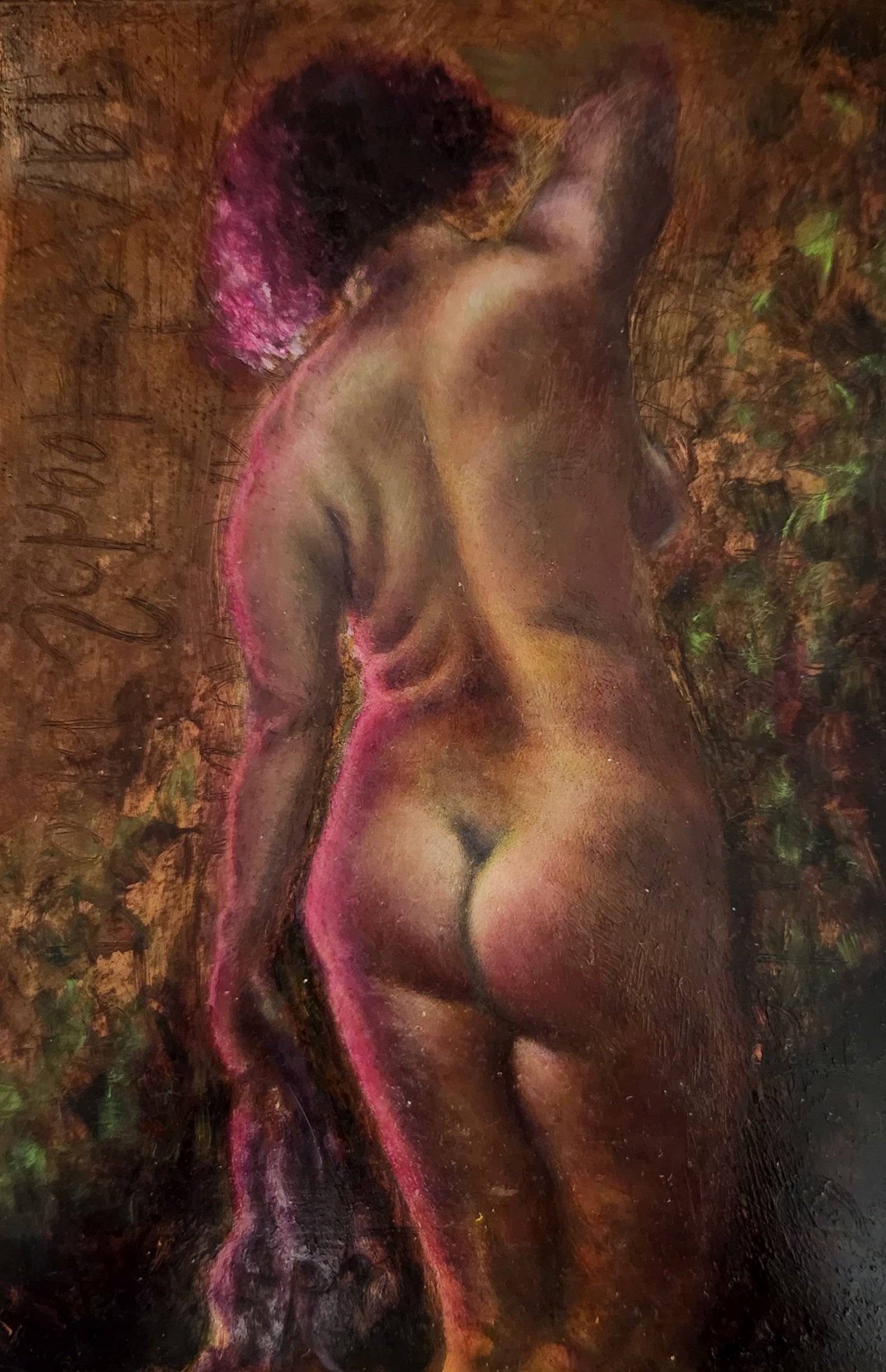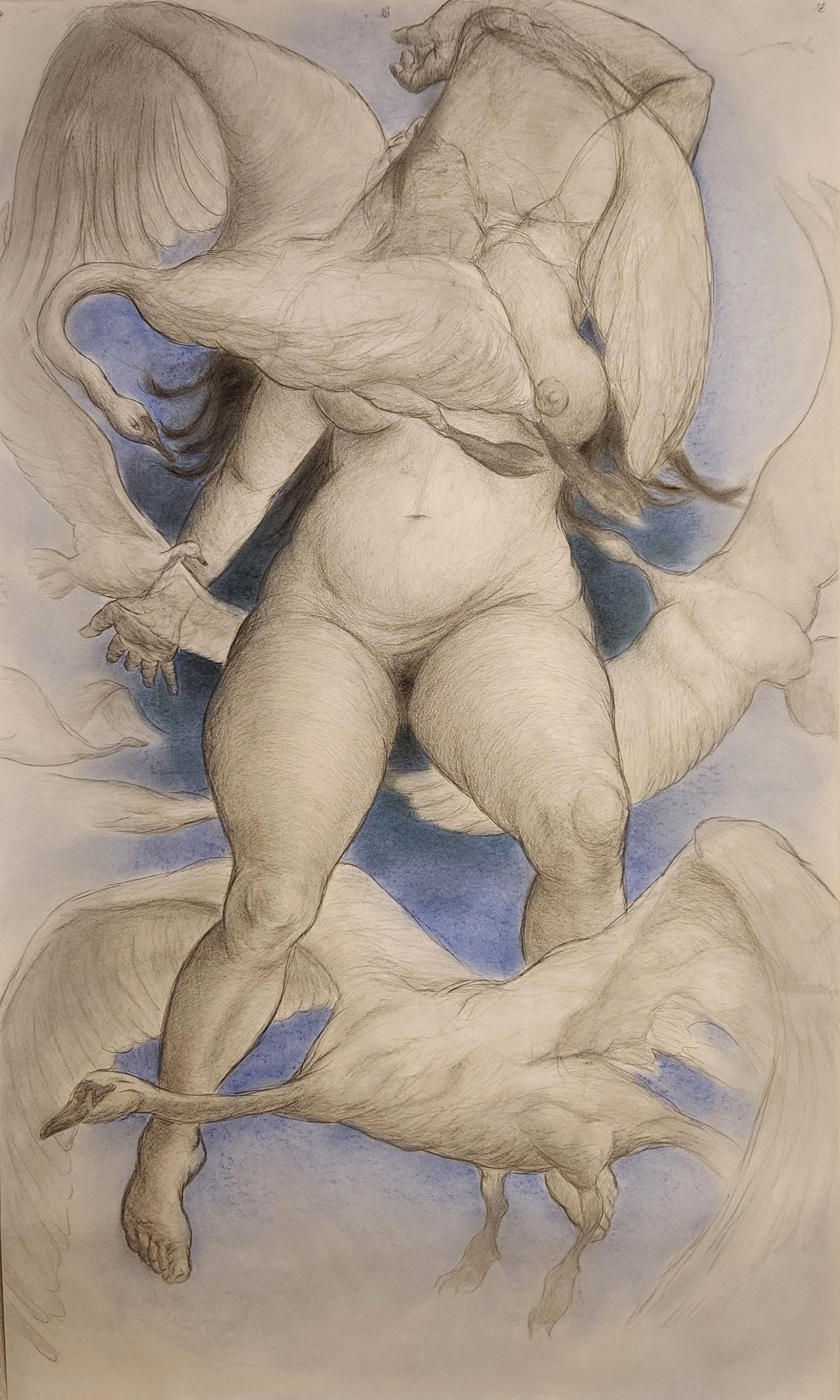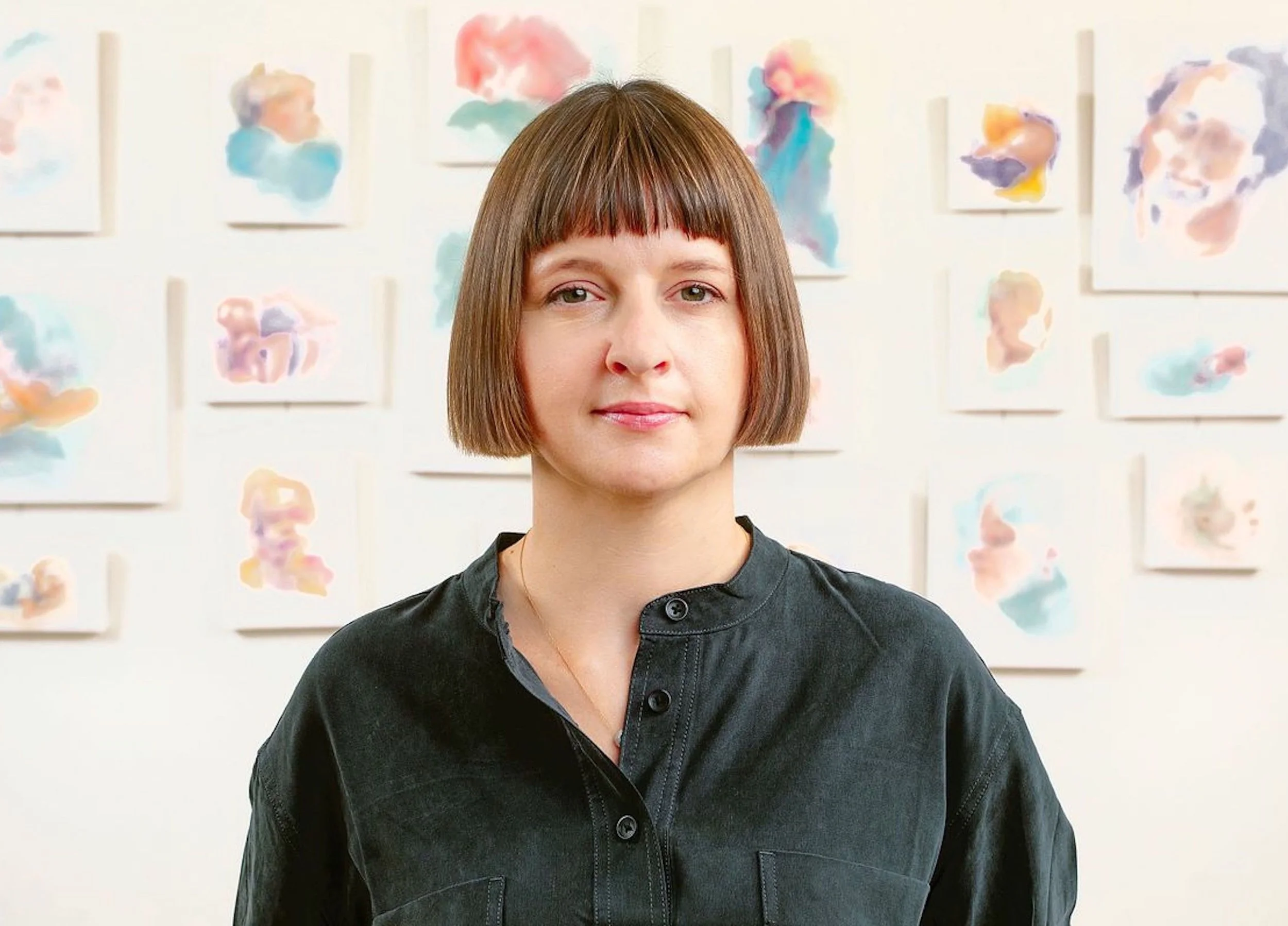Interview with artist Jennifer Smay
Jennifer Smay is a representational artist based in Northwest Arkansas. Her extraordinary paintings in oil and egg tempera, and drawings in graphite and pastel explore the human form because, as she says, “…what is more beautiful than the human figure.” More of Jennifer’s work can be found at her Instagram and at her website jennifersmay.com.
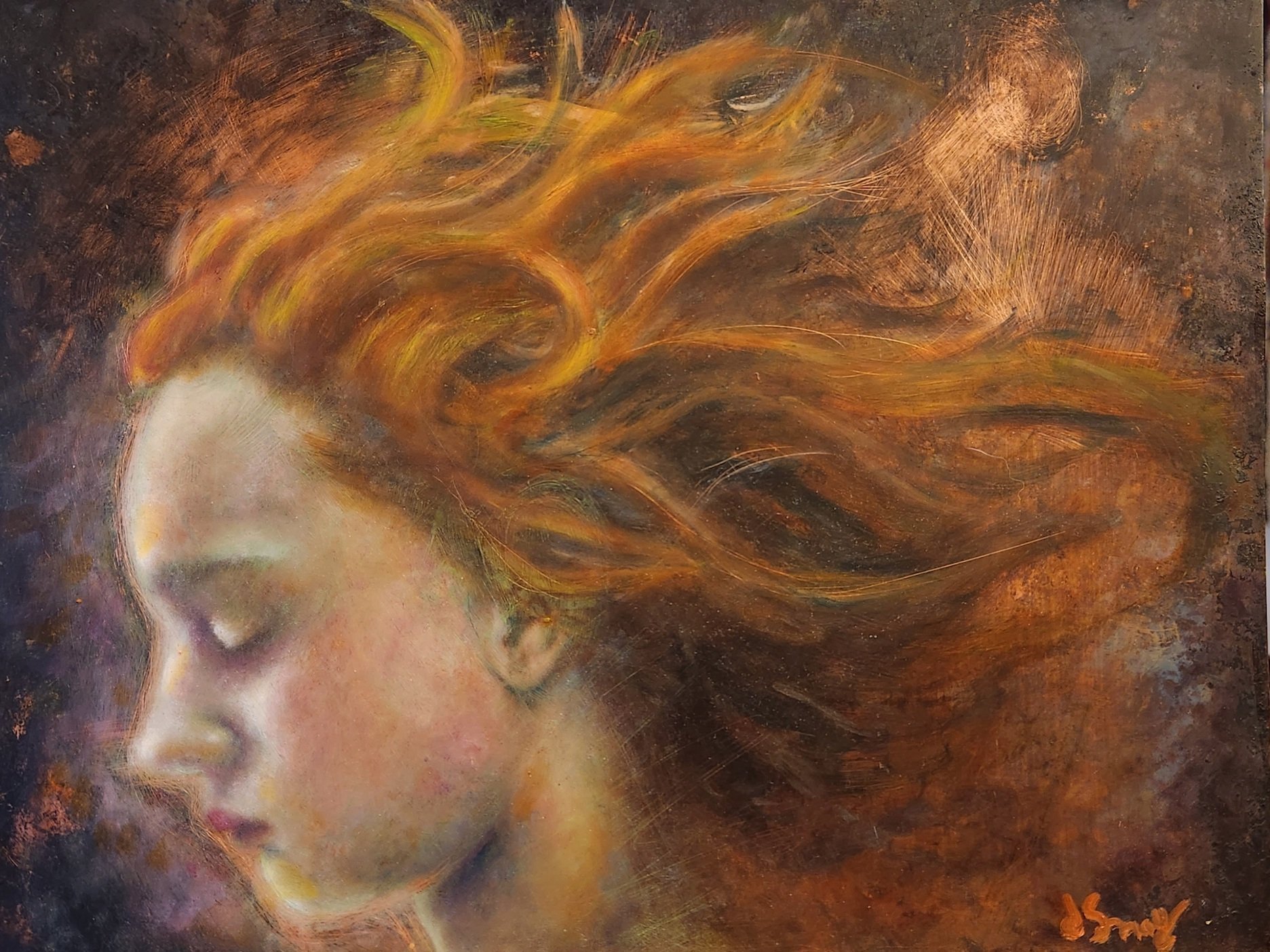
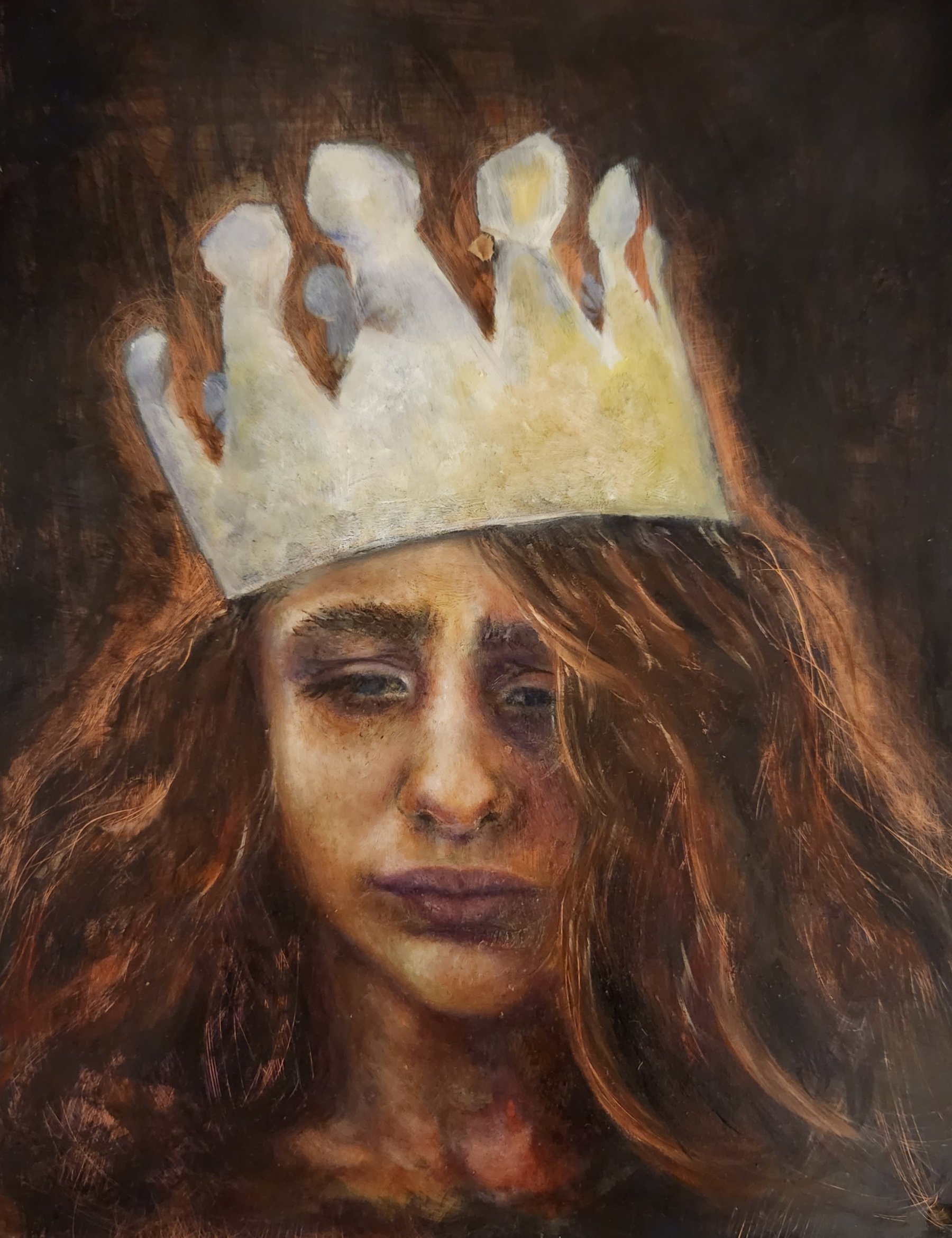
AAS: Jennifer, I believe you are originally from California – is that correct?
JS: Yes, that is right. I was born in Santa Ana and grew up in the Inland Empire. My parents moved around a lot and just before they divorced, settled in Pedley, where I lived for many years. Pedley was considered somewhat rural back then, mostly horse properties. It was hot, dry, and smoggy but life in Pedley was a pretty magical time for me.
I was really given this great freedom to roam and imagine and explore with few restrictions. The neighborhood was filled with kids. Behind our house was a small reservoir called Horseshoe Lake – wild and untended. The lake grasses grew so high that they would collapse under their own weight and form little caves that we loved to explore. Next to my house was a big, parched field where I spent many days riding bikes, motorcycles and horses; I loved to dig holes in that field for mud baths, soaking in the cool mud, trying not to get bit by fire ants. Just a few houses beyond the field, was the Santa Ana River. We would hike through that river, pushing against the tall reeds, sinking to our knees in the sand, praying it wasn’t real quicksand. I feel so lucky for that time in my life.
Eventually we moved, but we stayed in the Riverside area until I relocated to Arkansas. It was twenty years ago, when my in-laws moved back to North Central Arkansas. I felt ready for some adventure and so, sight unseen, I agreed to move too. This was before Google. It never occurred to me to do research on the place. And I had never traveled so I didn’t appreciate what I would be giving up. I just heard it was beautiful, looked at a few photos, and went for it.
The culture shock was pretty intense. Although I grew up in a smaller city, the surrounding areas were densely and diversely populated, rich with culture and opportunity. To give you some perspective, I was never more than an hour's drive from Los Angeles, and always just a few miles from some of the best universities in America; a bounty of opportunity was just outside my doorstep. The move was eye opening.
I regretted my decision immediately, but once we moved it was too late- we couldn’t afford to go back. The lack of opportunity in rural Arkansas scared me into action. I enrolled in college, made the long commutes to campus, and saw it through to a graduate degree. Now I have a good job so I can make lots of art and enjoy the beauty of Arkansas without much worry, and so I am happy.
AAS: Were you exposed to art and artists growing up?
JS: Not in the home. I wasn’t exposed to art until I met my friend, Rachael, during 9th grade. Rachael was an artist in the truest sense of the word- she lived the Art Life, as David Lynch calls it. Rachael painted or drew every free minute of every day. She never left home without a sketchbook. The fact that she was always at it, and I was always with her, made it natural for me to draw and paint more. Her parents were supportive and enrolled her in college art classes back then. Rachael would tell me the things she learned in her classes and demonstrate techniques. I sucked for a long time but with her help and a lot of practice, I got better. I felt lucky to have her as a friend because drawing was something I felt compelled to do and I wanted to be good at it. Be that as it may, I still didn’t consider myself an artist or what I was doing to be making art. Art/Artist, these were not a part of my vocabulary back then so for me it felt like I was just doing my thing in the same way all boys rode skateboards- none of them thought they were going to be pro skaters, right, we were all just doing our thing. I didn’t start thinking of myself as an artist until I was much older.
AAS: Where did you learn to draw and paint?
JS: One day in the high school library, I came across a book of William Blake's works. When I first laid eyes on the Great Red Dragon paintings, oh, boy, was I blown away. At that point I had never seen magnificent art. I had never been to a museum or any kind of art show. I didn’t know any artists outside of Rachael and she was young like me. And so I could not believe something so beautiful, so magnificent, was even possible. It was inspiring. I checked the book out of the library and went straight to Rachael's house. It must have been late spring because I sat at her kitchen table while her Dad was next to me doing taxes, and there it was that I created a copy of Blake’s, ‘Satan in his Original Glory,’ in pastel and graphite.
As I was working on my copy, I thought of a person I knew, a person who was beautiful but a very bad influence. The next day, I gave my Blake copy to this person, and I haven't seen the person or the drawing since. I wish I could see the drawing again. I do wonder if it was any good. After I showed the drawing to the person I gave it to, I put it in a book on their shelf. So maybe someday someone will find my Blake copy in a book at Goodwill or something. I don’t know, whatever happens, I am still moved by Blake's work, and it has been in this way, that I have taught myself to draw and paint. I have no formal training or education in the arts. If I feel moved to make something, I figure out how to do it, and this is always how it has been.
AAS: I want to ask you first about Red Giant. It is a fascinating painting on many levels. It is a wonderful portrait, but it then transitions into this textural explosion of color. Is the effect a result of painting on copper?
Red Giant, 9” x 12”, oil on copper
JS: It isn’t necessarily the result of painting on copper. Typically, before I start a painting on copper, I will use some different techniques to develop a patina on the metal. While I was treating this particular piece, I got distracted and left it unattended, when by chance a plastic bag landed on the copper, causing some unusual markings to develop. I thought these unexpected markings would be an interesting element to incorporate into this painting of my firstborn.
I have always considered my firstborn to be an old soul. And if you know anything about stars, you may recall that a red giant is what some larger stars become at the end of their life cycle, when they are very, very old. I made this mental connection between the old soul, his red hair, and the idea of a red giant representing something with the wisdom of the ancients and so I wanted to paint this idea. Initially, I planned to emphasize the red in his hair in a more straightforward way, but the markings caused me to reconsider how this was executed. This is not an uncommon way for my paintings to develop. I usually start with an idea of where I am going but I change my plan as things happen during the work.
AAS: Tell me more about the process for painting on copper and why did you start using copper?
JS: When lockdown happened one of the artists I most admire, Steven Assael, started streaming painting presentations online. Maybe he did it before the lock-down too, I actually don’t know, but I didn’t notice the streaming until the lock-down started. And so he would tell the viewers of these presentations - you can use this or you can use that for your painting surfaces, you can use whatever you want, but I am going to use copper. And so I figured if this amazing painter is using copper, then I am going to use copper too. It worked out well for me because I prefer painting on very smooth surfaces. Even when I am painting on canvas, I try to make the canvas smooth with lead oil ground so the texture of the linen cannot be felt through a brushstroke.
As for the process, it is pretty easy. I just sand out the area that I intend to paint, clean it, rub it down with garlic, and start painting. I don't know what the garlic is all about, but it's the way I was taught to prepare the surface, so I continue to do it. You can’t really use an under drawing with this technique, but I’ve grown to prefer this process too. Working without an under drawing makes the piece develop in a more fluid way; the boundaries of an under drawing can sometimes feel inhibiting.
AAS: I have to say that maybe my favorite piece on copper is A Moment in Vacuity. It is an extraordinary portrait of someone – maybe imagined? Tell me about it.
A Moment in Vacuity, 9” x 12”, oil on copper
JS: With features so pronounced you may think he is imagined but no, this is my father. My Dad was a funny guy, always crafting concoctions with his chemistry set, rebuilding engines, making pinatas, reloading bullets. There wasn’t anything he couldn’t fix or make. He was a professional machinist, and a Speedway pit mechanic seasonally but at some point he got involved in manufacturing drugs, ended up in the clinker, and spent several years being homeless. For all of his missteps, he has always treated me and my sister with great reverence. Today, he is living in a nursing home with dementia. He can’t talk anymore and he doesn’t know where he is but through the emptiness, he still seems to have a sense of who I am to him; he still treats me the same way. This painting really captures his current state of being. It is one of my favorite paintings too.
“The arts that are most inspiring to me come from musicians, comedians, writers, and filmmakers. These are the artists whose work moves me emotionally and helps to get ideas flowing, and ideas are the most important thing.”
AAS: Your work is about the human form, especially some of your drawings, which are large scale and could be scenes from a Renaissance fresco. Are you fan of art history and are you inspired by it?
JS: I have spent a lot of time researching historical painting processes, especially for my egg tempera pieces. And whenever I have difficulty achieving a certain effect, I tend to look to history for guidance, old paintings, drawings, anatomy books, etc. But generally speaking, I wouldn’t say I have a serious interest in art history. The arts that are most inspiring to me come from musicians, comedians, writers, and filmmakers. These are the artists whose work moves me emotionally and helps to get ideas flowing, and ideas are the most important thing. My ideas almost always center around the human figure or faces; it has been this way since I was young, trying desperately to make images of people that looked right. As my skills have developed, I've challenged myself by choosing increasingly difficult poses, and portraits. Portraits are a great way to practice particular techniques in a smaller, compartmentalized way, while still allowing for an infinite amount of expression and storytelling. Barring a few special cases, most humans can read the faces of other people and gather a tremendous amount of information about how the other person feels; this makes portraits an effective way to communicate an idea. My love of the figure comes from a similar place and of course, what is more beautiful than the human figure? It never ceases to amaze me, in all of its shapes, ages, and sizes, and it gives me great satisfaction when I feel I've gotten the figure or portrait to look right.
AAS: Don’t Be Afraid is one of those pieces. Tell me about it?
Don’t Be Afraid, 7’ x 3.5’, graphite and pastel on paper
JS: Don’t Be Afraid is about fear of the unknown. And I thought, what is more frightening than falling from the heavens? The goal was to capture the figures in free fall from life, which is impossible to do because a model can’t fall for a pose. So these figures were drawn in pieces- one extremity at a time, and the torsos were a bit of guess based on my knowledge of anatomy and imagination. The figures are not perfect, but I am never aiming for perfection in the work, I prefer the nuances that come out of working from life and imagination. I ended up adding the birds because they help inform the movement of the falling figures and I think they look cool. And you know, I also really love birds, especially mean black swans with red eyes.
AAS: You did a self-portrait, Self Portrait in Pink, that has an 18th century French aristocrat look. It is marvelous, especially the candlelight effect. It must have been fun to paint.
Self Portrait in Pint, 12” x 9”, oil on copper
JS: I know I’m not the first artist to say this, but I actually don’t enjoy self-portraits - they are so hard! Making a good self-portrait requires stepping outside of yourself and seeing something different than what you think you see, if that makes sense? Until it becomes easier for me to make a self-portrait, I feel like they continue to be good practice, and act as a benchmark to measure my skills across time, so I make them occasionally.
This self-portrait was inspired by my love of Coppola’s film, Marie Antoinette. In 2020, before I knew the lock-down would be happening, I made a Marie Antoinette costume for the annual Halloween parade in Eureka Springs, inspired by the Easter palette you see in the film. The parade ended up being canceled so I didn’t get to wear the costume outside of my neighborhood but my wig was amazing. I thought it would make a good prop for a self-portrait. It was a few years later before I actually made the painting but I’m glad I did- the wig is falling apart now!
AAS: In addition to oil, graphite, and pastel, you also use egg tempera to produce some wonderfully luminous effects. Tell me about The Sun is Shining.
The Sun is Shining, 24” x 34”, egg tempera on wood panel
JS: I have only been painting with oil for 3-4 years. In the past, I worried about working with chemicals and the paint was so expensive, but I didn’t care for watercolors or acrylic. In my quest for alternatives, I learned about egg tempera. I began to research the processes for this technique which led me to discover tempera greats like Botticelli, Wyeth, Julio Reyes, and one of America's living masters, Koo Schadler. I emailed with Koo, who was kind enough to answer my questions and provide me with a list of reference materials, which is what ultimately got me to start painting in egg tempera.
The Sun is Shining was my response to learning about Botticelli and staring at his Birth of Venus using the Uffizi magnifying feature for endless hours. I was amazed to learn Botticelli's Venus was mostly painted from memory because his model died. I wanted to try and do the same thing, paint from memory, using some of the elements seen in his work, like the flowers and hair. I was not able to successfully paint this from memory, but I am still pleased with the end result.
Egg tempera is a fantastic way to paint. The work will last for centuries and retain its vibrancy which is unique to this medium. But the process is sensitive; the yolk to water ratio must be right, the gesso must be properly prepared from rabbit skin and properly applied, the layers must go on very thin in dozens to hundreds of layers- it is a really scientific way to paint and blending details is very difficult. Lately, I want more freedom and oil is better suited for that desire. And of course, now I know I don't need chemicals to work in oil so my fear has abated; one only need oil and dish soap. So, I don't work in egg tempera as often as I used to but that could change at any time.
AAS: You have work in the 2023 Rosenzweig Exhibition at the Arts & Science Center for Southeast Arkansas, which is on display through mid-October. What can we expect next from you? Do you foresee any changes in the direction of your art practice?
JS: At the moment, I am working on a body of larger scale pieces that feature human figures, using my life drawings as reference. You can expect my future paintings to be much bigger and I guess, more narrative in nature. I haven’t been sharing this work online because the plan when I am finished is to begin shopping for representation. I’ve had success selling work through my website and social media, but I’m ready to let a professional handle that part of the process so I can focus more time on painting. If all goes the way I’d like, you’ll be able to see my work regularly gracing the walls of a successful gallery in the near future.
